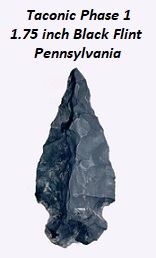This point is primarily found in the mid to lower Hudson River Valley of New York, New Jersey and into Massachusetts and Connecticut.
TACONIC (Stemmed) – was a mountain building period that ended 440 million years ago and affected most of modern day New England. This point type was named by self taught archaeologist Louis A. Brennan for specimens recovered from sites in the river valleys of the Taconic Mountains in New York. They are medium sized (1” to 3”), long, slender projectiles and knives with contracted stems, straight bases and weak shoulders that are square or round. Blades are parallel and beveled on reworked examples. There are four varieties: (I) Knobby Stems. (II) Square stem, narrow blade. (III) Square stem, broad blade. (IV) Pinched stem (fishtail). Distribution includes New York, Pennsylvania, Maryland and they were in use during the Archaic period. Reference: Brennan, Louis A. et al. 1970, The twombly Landing Site II. The Bulletin, New York State Archaeological Association, No. 49, pp 13-29, Ossining.
Most points typed as Taconic have long shoulders with a small stem giving the point a contracting stem appearance. Examples with the squared stem or slightly expanding stem are commonly typed as Lamoka points and examples with a fishtail appearance are commonly typed as Orients points.



Brennan was a respected self-taught archeologist who did extensive work in the Lower Hudson River basin. He published over 53 professional articles. This point was identified in a professional publication and has many professional references. Most discussions regarding this type, professionally, are related to the Taconic Tradition. This is considered a valid type.
.